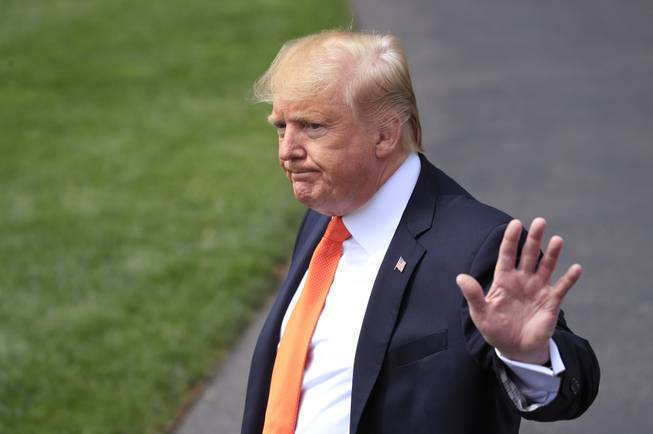
Manuel Balce Ceneta / AP
President Donald Trump waves after talking to reporters as he leaves the White House in Washington, Wednesday, April 24, 2019, for a trip to Atlanta with first lady Melania Trump to participate an opioids summit.
Friday, April 26, 2019 | 2 a.m.
View more of the Sun's opinion section
Those who contend that President Donald Trump has been unjustly accused of racism and sexism might want to pull their heads out of the sand long enough to take a look at a new report about judicial appointments.
The report, from the Congressional Research Service, shows that 90 percent of the Trump nominees who have been confirmed for positions on appeals courts were white. The number is even higher for nominees confirmed for federal district courts — 92 percent.
What’s more, 80 percent of those appeals court judges were men, while 74 percent of the district court judges were men.
Meanwhile, when it comes to black and Hispanic judges, Trump’s record is particularly appalling — zero appeals judges and just 4 percent of his district court nominees. In addition, he hasn’t nominated a single Native American judge.
That’s clear evidence of racial and gender bias, right there in black and white. Mostly white.
Trump’s appointments are disturbing not just because they offer a reflection of his biases, but in terms of their repercussions on the federal justice system. Reducing the diversity of courts could have a profound effect on such matters as gender/LGBT equality, women’s rights, workplace discrimination and fairness in sentencing between white and non-white offenders.
It’s not that white male jurists are inherently unfair — that’s not the case whatsoever. But it’s crucial that a judicial corps reflect the demographics of a society.
Laila Robbins, a research and program associate at the Brennan Center for Justice at the New York University School of Law, said diversity strengthened decision-making among judges by exposing them to the various backgrounds and experiences of their colleagues.
“Without insight from colleagues who’ve experienced life as a woman or a person of color, courts are ill-equipped to decide cases that affect an increasingly diverse America,” she said during a telephone interview.
In addition, Robbins said, judges of color provide role models for ethnic groups that are underrepresented in the legal profession. Broadening the diversity of the courts also improves trust in the judicial system among the public.
“There’s a great quote by former Ohio Supreme Court Justice Yvette McGee Brown who says that the public perception of justice suffers when the only people of color in a courthouse are in handcuffs,” Robbins said.
As reported by the Huffington Post, Trump’s record after two years includes not nominating a single black woman and only two LGBT judges, neither of whom has been confirmed. In addition, more than 80 percent of Trump’s nominees have been members of the staunchly conservative/libertarian Federalist Society.
And as judicial expert Russell Wheeler of the Brookings Institution found in a study issued in December, many of Trump’s nominees are quite young, meaning they’ll have a long-term effect: “When Trump replaces a 72-year-old slightly right-of-center judge with a 45-year-old conservative firebrand, it’s not really apples for apples,” Wheeler told The Washington Post.
The slightly good news is that most of Trump’s nominees are for positions being vacated by judges nominated by former Republican presidents, so the shift thus far is fairly slight in terms of political ideology.
But clearly, Trump is working to turn back the clock on the court’s diversity in defiance of societal trends. And with Senate Republicans all too eager to approve his nominees, the damage only figures to get worse this year and next.
It’s one of many things that voters should remember when they go to the polls in 2020.
